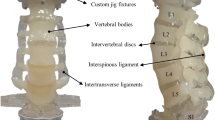Abstract
We evaluated stresses in the anterior middle third of the tibia that have been reported to predict a poor prognosis for tibial stress fractures compared to other predominant sites (posteromedial regions of the distal third and proximal third). The effect of two different loads (bending-compression load and torsional load) on three sites was investigated using a three-dimensional finite element method. The model was constructed using the tibia, fibula, proximal tibiofibular joint, interosseous membrane, and tibiofibular ligament based on computed tomography scans obtained at 4-mm intervals of the lower leg of a 20-year-old woman who exhibited no abnormal findings on roentgenograms. First, a normal model was constructed using normal material properties, and then the model was modified to produce fracture models by varying the mechanical properties of each predominant site and expanding the area in three gradual phases on the assumption that the fracture advanced in three phases. Each model was tested against the same two loads, and stresses at the nodal points on the border of the fracture area and normal area were compared in each cross section to determine the effect of the load on fracture advancement. In response to torsional load, both the normal model and fracture models tended to show higher values for the posteromedial distal third than the anterior middle third. By examining the bending-compression load it could be seen that the mean peak value significantly decreased between the first and second phases in fracture models of the anterior middle third. This finding was inconsistent with our previous belief that the bending-compression load would have more serious consequences than the torsional load. In contrast, when the area of fracture was expanded into the third phase, maximum values were significantly higher than during the second phase. No similar finding was observed for the posteromedial distal third, suggesting that the anterior middle third may have the same stable biomechanical conditions as the posteromedial distal third at an earlier stage and thus have little influence on fractures. When the fracture is more advanced, however, the conditions change suddenly, and a bending-compression load may adversely affect the mechanical conditions in this area and thereby cause complete fracture.
Similar content being viewed by others
Author information
Authors and Affiliations
About this article
Cite this article
Sonoda, N., Chosa, E., Totoribe, K. et al. Biomechanical analysis for stress fractures of the anterior middle third of the tibia in athletes: nonlinear analysis using a three-dimensional finite element method. J Orthop Sci 8, 505–513 (2003). https://doi.org/10.1007/s00776-003-0671-5
Received:
Accepted:
Issue Date:
DOI: https://doi.org/10.1007/s00776-003-0671-5




